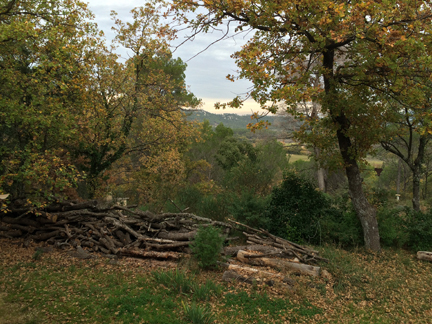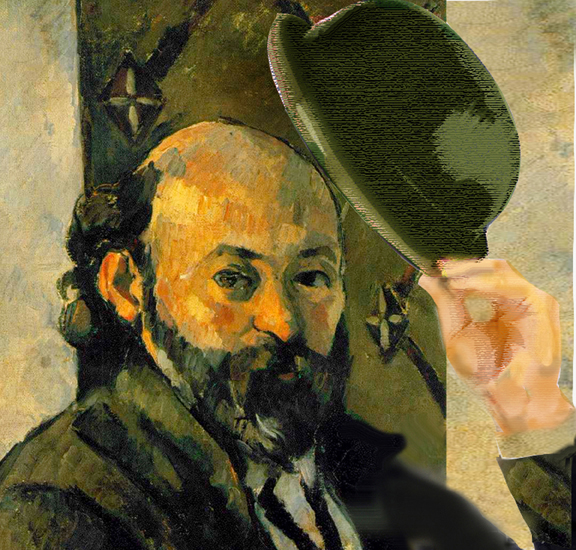Arrival: greeted by
Cézanne
 |
| from Janet's studio window in rural Provence, France |
For an idea of the glow here, contrast this photo taken
outside my 'studio' here with one in my last column from Vancouver-- also
beautiful, I think, but in a different light. My art space here is very
different from my little art-house on Saturna Island, but it's workable. I've
set up a room here with the art materials I'd unpacked and a make-shift easel
of canvas tacked to a thin old piece of wood mounted on rusted garden stools
I'd scrounged.
I'm settled for several months in a country house near
Aix-en-Provence, home of Cézanne. He is my constant neighbor, whose round bald
pate I love and in tribute to whom I've made the Bienvenu digital montage for you. Not only did Cézanne love and
never leave Provence for long, but he saw it as few before him ever had. Now, not
far from where he lived, I see the real Mt. Ste. Victoire appear the way he
painted it again and again: planes of broken color that abut and define mass
and that move with the light.
 |
| Cézanne's personal welcome (JS digital montage) |
Visual art has a way of teaching us to look in different
ways and perhaps to see more. Cézanne's Mt. Ste. Victoire is not just a
mountain. It's a changing field of colored planes, a template for a new way of
looking and of seeing, an icon in art history, a symbol of a place and of a
devotion. This is what it's like to live inside a painting. I start seeing the
trees around me as Cézanne trees, the sparks of light as Van Gogh painted them,
the colors as both organizing and breaking shapes into Monet-like impressions,
the polymorphous possibilities for Picasso-esque forms.
It's a fantasy to think of long-gone painters as companions,
but I do. On one of my hikes up Mt. Ste. Victoire, groaning my way along one of
the longer and steeper trails, I kept looking for PC+EZ cut into tree trunks, a sign of the boyhood friendship of Paul
Cezanne and Emile Zola, who walked these same trails.
 |
| view from one of many hikes I took on Mt. Ste. Victoire (JS photo) |
Inspiration
Inspiration is everywhere. It's in the abundance of nature, the pace of agricultural
rhythms, in the sensory variety of the sights, sounds, smells, and textures
that weave through daily life. It's in the vineyards, olive groves, and spent
fields of lavender, the red and ochre earth you walk upon. The natural palette
is gorgeously harmonious. The ground varies from luscious red-browns to an
eye-dazzling range of rich yellows, set in perfect contrasts of deep and
diminished sap-greens that slide into silvery olive tones, and blues to break
your heart. All the natural pigments could make you as delirious as they might
have Van Gogh. Nearby Roussillon, perched atop on of the largest ochre deposits
in the world, is famous for its natural pigments, used by painters for
centuries... and now I've picked up some too. |
| JS photos taken while walking along natural ochre trails of Roussillon; natural ochre pigment purchased there, beside vase |
It's in the endurance of ways of life here that persist
across centuries of turmoil and war, in the ancient ruins you come across in
almost every village, the many ancient towns with modern people living in homes
with stonework dating back before the Caesars. The past is alive, along with
the present. History is apparent even in street names like Rue Verrerie/Anciano Carriero de la Jutarie, written in both modern
French and older Provençal (or Occitan). It's in the daily life of people who
value living well: the well-prepared meal, the stylistic presentation, the
attentively tended market stalls, the butcher who tells us not to miss the art
show at the chateau. It's in the art based on this region that now invites you
into it, up close and personal.
Ordinary life becomes extraordinary when it breaks out of
the familiar or routine. Art does something similar when it shows us an apple
like we've never seen it before. Travel and living in a new location intensify
and differentiate experience, pulling it out of the ordinary lull. Shopping in the local outdoor
markets, learning which ones to go to for what, listening to a different
language, learning how to go about taken-for-granted things back home become
adventures in living daily life. Such sharpening of one's attention is bound to
influence how one sees things: teaching us how we need actively to look first,
and then to look again. It changes one's perspectives by offering several
different ways of looking at once. Not the easiest position to be in for
holding confident opinions, but a self-reflectively open position that's very valuable,
I think, for life as well as art.
I'm impressed by the attention given to public art and exhibitions
everywhere I go. Even my town (not an art centre) has a local vernissage every few months. The nearby
village of Loumarin, with only about 1,000 dwellers, boasts more than a dozen independent,
active art galleries. This focus on art, so evident in the entire Provence
region, seems to go along with a taste for reading and writing. Even in tiniest
villages, you find busy independent bookstores and papeteries with their assortments of writing implements (fountain
pens!) and papers, the tangibles of a literate culture. Vintage books and pens are
also displayed traditionally in weekly open-air market stalls.
Making it as an
artist?
I've visited so many nearby places, gone to so many different
galleries and art events, and spoken with so many people here, including art
students, teachers, and local gallerists, that I'm convinced this region maintains a vital cultural connection to the arts. Art centres and
interests abound not only in the central city of Aix-en-Provence, long known
for its artistic and cultural life. The many tiny Provençal communities have
their art spaces and avid enthusiasts. Yet, emerging artists still typically
take a long time to emerge.
Philippe, a mid-career artist/instructor for a workshop I
attended gave me his overview of some challenges facing a painter who wants to
make a living and gain recognition solely by art. They turned out not be so
different from the challenges facing Canadian artists. He said the smaller
galleries don't do enough to promote their artists and the larger ones are
business conglomerates that deal only with known artists or decide in common
which few new ones to promote. Although Philippe shows his paintings in local
galleries, the best promotion, he thought, is to have them in the big art fairs
that cost a big chunk of money but also attract the big gallerists. In
contrast, "no problem" was the answer I got when asking the same
question of Max, a fairly recent multimedia graduate of L'Ecole Superieure
d'Art in Aix, then showing his intricate computer graphics at a group show
promoted by the school. Max said he showed in all sorts of venues (not just
galleries) in Belgium, France, and London, as well as having an internet presence
with his abstract music. Aside from their artwork, is it their relative life
positions or reference points for "success" that account for the
somewhat different views of these two full-time artists?
Is what you paint
affected by where you are?
Of course, we all affected by the culture we live in and
absorb or react to, some more knowingly than others. Even the contemporary
"culture" of painting tells us what's hot and what's not. But how
much is the content and style of what visual artists paint related to their
physical setting?
 |
| JS painting, Provençal Suite 1 (Abundance), www.janetstrayer.com |
For plein-air artists, certainly it must be. But what about
studio-based artists, abstract painters, or those who work from a more
conceptual or imaginative base? My own recent experience tells me it is, for
me, at least. I'd left for France while a show of my "Spirit of
Place" semi-abstract paintings was on exhibit with the North Van Arts
Council. I'd was eager to continue further with abstract painting. But after
arriving here, "Abundance" is the first painting I did (in progress).
I felt impelled to paint it just by being in the country house we'd rented and
by Cézanne's palpable imminence here. In a way, it's my homage to both. Surprisingly
to me, I couldn't get to work on anything else until I'd done this painting,
which subsequently led to a couple more like it. While then pushing into work
with non-representational abstracts, as I'd originally intended, those
paintings kept changing into more impressionistic landscapes filled with the
colors, textures, and sensations surrounding me. If an "abstract"
painting of Provence results, good, but I'm ready to go with the flow for now.
Aix-en-Provence
Entire books are devoted to Provence, a region that includes
multiple micro-climates and cultural influences from Celtic and Roman to
Catalonian and North African. Aix-en-Provence is one of its handsomest towns,
with its majestic Cours Mirabeau main street, one of largest and most
recognizable fountains in France, and its trendy people-watchers sitting in
posh cafés dating back to 1792. I'm fond of this ancient and youthful town that
welcomes foreigners but keeps its traditions and a historic ability, despite
changes of fortune, to embrace l'art de
vivre. Of the many photos I'd like to share with you from Provence, here's one taken in Aix just after the horrible
terrorist events in Paris. The town is alive with people, as usual, here celebrating
in traditional costume an old Provençal dance with fife and drum.
 |
| traditional Provençal costumed folk dance with fife and drum (JS photo in Aix-En-Provence) |
Á bientôt, for now. Looking forward to being en route with
you in the next installment... in France or perhaps we'll already be in Italy!
Happy Holidays and Best Wishes for the New Year!
More Creative Life News
You can read and see more about creative life, travels, tips and creative adventures by this itinerant artist at Creative Life News at https://www.janetstrayer.com
Regards, Janet




